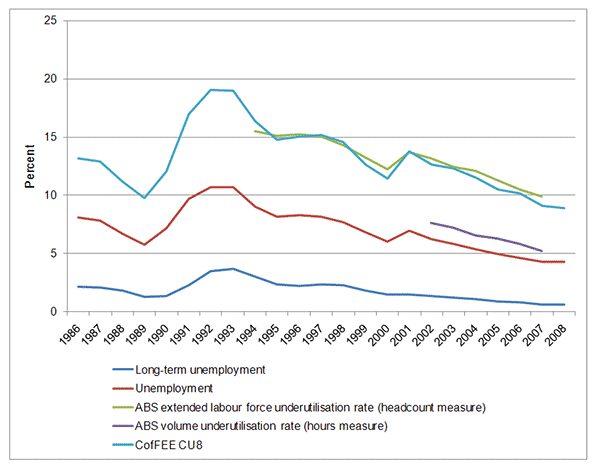
Graph 2: Selected measures of labour underutilisation for Australia, 1986-2008 (Sources: ABS, CofFEE. ABS figures for September, CofFEE for August quarter).
Furthermore, particular segments of the labour market are affected worse than others in downturns, such as unskilled workers, NESB migrants, indigenous Australians and female casual and part-time workers. Unemployment and underemployment also tend to hit some industries and regions worse than others, particularly those already in decline (e.g., car-manufacturing in South Australia). When real wages fall in recessions, many workers in disadvantaged groups (who tend to be concentrated in low-wage occupations) that do keep their jobs also tend to suffer worse than others.
Policy options
There are a number of options available to mitigate these effects. A mixture of macroeconomic, industrial relations and unemployment policies are required during the recession and throughout the recovery period. Workers, skills and jobs must be better aligned in an efficient and timely manner.
Advertisement
Recent fiscal and monetary stimuli by the federal government and Reserve Bank will most likely take over a year to kick in fully, yet will do a lot to minimise the extent of the downturn and rise in unemployment. Solid fiscal and monetary management since the early 1990s has meant that any recession here will not be as severe as in other countries. The government anticipates its fiscal stimulus packages and budget deficits will boost economic growth by 0.75 to 1 per cent by 2009-10 and preserve 90,000 jobs over the two years. Macroeconomic policy has entered a highly stimulatory phase and will exert a positive effect on labour demand.
Industrial relations and labour market policies also have a role to play by minimising job losses in the downturn. In a recession, most employers are unwilling to increase their costs by hiring more workers no matter how low wages fall, because deficient aggregate demand creates no incentive to expand output. Calls by business lobbies for the Rudd Government to scrap its proposed industrial relations laws, or to pressure the Fair Pay Commission to lower the minimum wage, thus aren’t persuasive strategies to boost aggregate demand and employment.
Rather, the focus needs to be on avoiding as many retrenchments as possible and ensuring that, once economic growth reappears, workers who lost their jobs are able to easily re-enter employment. Since most workers possess firm-specific knowledge and skills, and employers incur on-costs when they hire workers again, firms tend only to sack workers en masse as a last resort. There is thus scope to give firms greater flexibility to reduce workers’ hours while keeping them employed.
The Rudd Government’s new industrial relations laws have been controversial, but the economy’s short term problems need to be considered separately from the reforms’ long-run impacts on bargaining power and labour productivity. Temporary measures could be considered to assist firms to reduce workers’ hours and adjust employment contracts accordingly. The focus at the moment - for government, employers, workers and the unions - should be on retaining jobs rather than on re-weighting bargaining power or securing higher wage increases.
Several proposals have been put forward, such as a reduction in the minimum wage that is offset by a higher tax-free income threshold, leaving workers no less off but reducing costs to firms. Yet with deficient aggregate demand this may not do much more than permanently reduce tax revenues while low skilled employment is largely unaffected. Other schemes involve expanding job sharing, subsidising employment for unskilled workers and providing more funding for on-the-job training and apprenticeships. In one option, workers could take leave for several weeks at a time with the government paying them the unemployment benefit during this period.
Whatever schemes are implemented, the government needs to make sure that working remains sufficiently attractive compared to welfare, yet that unemployment benefits are still sufficient for the jobless to support their families on. Indeed, there is scope to adjust the obligations placed on recipients of the Newstart Allowance (unemployment benefits). Until recently, many of the NA rules were set to cajole the long-term unemployed into finding work in a booming labour market. The government has started to soften the assets tests for receiving the NA and is reforming penalties for rule infringements.
Advertisement
An extra $298.5 million in funding for the privatised employment services system has also been announced, to ensure that workers immediately qualify for job search assistance when they become unemployed (rather than having to wait three months). Extra funding will be provided for an additional 10,000 places in training programs to develop workers’ skills and facilitate transition towards work in different industries.
More resources must be provided to the Job Network agencies that help people to find work (and are now dealing with a growing number and diversity of jobseekers). There needs to be better oversight and regulation of labour market programs and how they are implemented (particularly in terms of assisting individual jobseekers), and improved co-ordination with - and funding of - education providers, especially TAFE. Well-targeted training is a valuable way to ensure workers’ skills can keep pace with evolving industry mixes and labour demand.
Specialised programs that target disadvantaged groups in the labour market, such as school leavers, NESB migrants, Indigenous Australians and single parents, also need to be devised or expanded. The long-term unemployed should be given additional assistance too, as a rise in the size of this group during a downturn can be very difficult to get back down afterwards.
A mixture of policies is needed to avoid serious labour market problems in the coming downturn. The last thing we need is a big rise in unemployment. Yet this downturn is not going to be as bad as in many other countries. With the right policies, we can not only reduce its severity, but also increase our labour productivity and economic efficiency well into the future by improving workers’ skills, encouraging greater workplace flexibility and dealing with the jobless more efficiently.